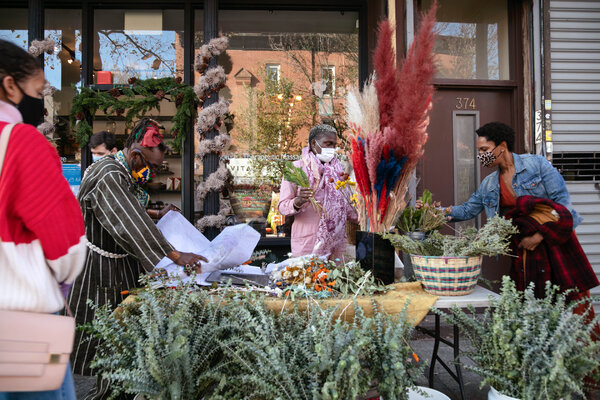Outdoor Dining Is a Hit. What About Outdoor Shopping? – The New York Times
Advertisement
Continue reading the main story
Supported by
Continue reading the main story
Outdoor Dining Is a Hit. What About Outdoor Shopping?
New York City’s Open Storefronts initiative lets retailers use sidewalk space in a manner similar to restaurants. So far, the program is a flop.

By
Hoping to survive the economic toll of the pandemic, nearly 11,000 restaurants are now part of New York City’s outdoor dining program — a program so wildly popular that Mayor Bill de Blasio made it permanent.
With that kind of success, the mayor turned his attention to another popular activity: shopping. In late October, he announced the Open Storefronts program, which allows retailers to use their sidewalk space to conduct business outdoors, in a manner similar to restaurants.
But so far, the program is a dud: as of Tuesday morning, only 563 businesses had applied. Mr. de Blasio has said 40,000 businesses are eligible to participate.
There was a lot going against it. Business owners said the program was complicated, costly and too little, too late. It was scheduled to end on Dec. 31; only 10 businesses in Staten Island had applied, and most applicants were located in Brooklyn and Manhattan. Some business owners said they were turned off by the rules, including space restrictions and a prohibition on heaters, a primary draw for outdoor dining as the weather grows colder. Others said they could not afford to pay employees to stand outside in the cold to watch over merchandise.
Several store owners said that unlike outdoor dining, the customer demand was not there.
“People have to eat, they have to socialize, but they don’t necessarily have to buy clothes,” said Liz Murphy, the owner of Slope Vintage in Park Slope, Brooklyn.
In a City Council hearing on Tuesday, Jonnel Doris, the commissioner for the city’s Department of Small Business Services, largely blamed an information gap and concerns about the transmission of the virus for the low participation rate.
Mr. Doris said small businesses receive a majority of their sales during the holiday shopping season, so his team was working to increase the number of participants.
A spokesman for the mayor, Mitch Schwartz, said in a statement that the city is “proud” to see that some businesses are taking advantage of the program. “Two things have been clear throughout this pandemic: small businesses need support, and New York City’s recovery depends on creative uses of the outdoor urban landscape,” he said. “Open Storefronts merges both.”
But using the landscape does not mean businesses will recover, some store owners said.
Ms. Murphy said she put two racks of clothing in front of her store this summer before the mayor unveiled the Open Storefronts program. Her sidewalk setup increased foot traffic, but did not grow her sales. She said she did not see the value.
Outdoor retail “isn’t going to save the company,” said Ms. Murphy, who did not apply to the program. “It’s not going to make my sales go up 20 percent. All it’s going to do is say to someone, ‘Hey, we’re open,’ but I could’ve just gotten a neon sign for the same amount of money that would’ve attracted the same number of people.”
While the program is wide-ranging — including clothing and food stores and repair shops, but also personal care services and even laundromats and dry cleaners — many retailers failed to see how it made sense for their business.
“The customer experience of visiting stores on Fifth Avenue is exceptional and based on what we know about our shoppers’ habits,” Jerome Barth, the president of the Fifth Avenue Association, said in an email. “They prefer the personal touch of walking into a store and enjoying that special degree of care.”
Still, some business owners were hopeful, willing to try anything to stay afloat. With the holiday shopping season underway, retailers are increasingly anxious about recouping losses incurred during the pandemic. According to a report by the Partnership for New York City, a nonprofit business group, approximately one-third of the city’s 240,000 small businesses may not survive the pandemic.
Some store owners began moving their wares to the sidewalk earlier this year as lockdown limitations lifted but people remained concerned about enclosed spaces. They made these changes before the city consented, leaving themselves open to receiving tickets or fines.
“The Open Storefronts initiative was more of a validation of something businesses had initiated themselves out of desperation,” said Kenneth Mbonu, the executive director of the Flatbush Nostrand Junction Business Improvement District in South Brooklyn.
Sidewalk vending, legal or not, has long been a familiar sight throughout the city, and is considered a quick and often cheap way to make sales: jewelry in SoHo, incense in Harlem, flowers in Midtown. But extending a brick-and-mortar business onto the sidewalk is rarer.
Khadija Tudor, the owner of Life Wellness Center, a massage and acupuncture studio and apothecary in Brooklyn’s Bedford-Stuyvesant neighborhood, has been selling merchandise outside without having had heard of Open Storefronts.
In 2006, when she and her husband opened the business, they would drag a massage chair to the sidewalk and offer it to passers-by, or have a table with plants and incense for sale. During the pandemic, they left the massage chair inside, but the area outside the storefront on Tompkins Avenue is bustling.
Ms. Tudor said sidewalk merchandise, like lush bunches of eucalyptus and sizable house plants, had always helped business. “But it’s not just outdoor sales. A big thing for us is being connected to the community,” she said. “We really consider community to be the backbone of why we’re even surviving and thriving.”
The stretch of Tompkins Avenue between Jefferson and Putnam Avenues was particularly lively on a recent November afternoon, full of outdoor diners and shoppers. Two more retail businesses also had wares on the sidewalk; one had clothing snaked up the scaffolding outside of the shop.
In Park Slope, also in Brooklyn, Annie’s Blue Ribbon General Store happens to be on a block that is one of the city’s “open streets,” which are closed to traffic at certain times. Bars and restaurants had been taking advantage of the additional space all summer, so when Ann Cantrell, the store’s owner, heard about the retail program, she jumped at the chance to apply.
“I just want to remain relevant and top of mind for our customers,” Ms. Cantrell said. Being outside “increases awareness and opportunity to be closer to the customer.”
Doing business outdoors helped salvage the Craft Studio, a Manhattan arts studio with locations in Tribeca and on the Upper East Side — not because of sales, but because Lindsey Peers, the owner, moved art classes and activities to the sidewalk. That meant caregivers and children could still participate in the classes the studios offered.
Ashley Butterman, a regular at the Upper East Side location, stopped taking her two young children when the pandemic took hold. Once the sidewalk classes began, she eagerly returned, happy to have found a way for her children to have play dates without having to enter a building.
“It provided a great way for us to benefit from all the things they do here and to support a local business, but also stay safe and comfortable,” she said.
While the sidewalk classes were successful in the summer, Ms. Peers said she thought she would get only one or two days of actual sidewalk sales in before the end of the year, even though she went through the formal application process. “I know I’m not alone when I say it’s a staffing issue,” she said. “To have a person stationed outside all day, and to make up for that revenue — it’s a gamble.”
Many store owners are avoiding the program entirely. Representatives from business improvement districts in Manhattan’s Chinatown, Bedford-Stuyvesant, Williamsburg and SoHo, and on the Upper East Side and Madison Avenue, all said that it was too soon to read the success of the program because of the low rates of participation.
DianSong Yu, the executive director of the Downtown Flushing Transit Hub Business Improvement District, said the program was not successful in his Queens neighborhood.
“One, local retailers are facing major competition from online retailers like Amazon, Walmart, and Target,” he wrote in an email. “Two, to operate outdoor retail, shops will have to hire more employees for the coverage. A risk most shop owners are not willing to take on. Three, Main Street is occupied by illegal vendors throughout the day. Tough competition for retailers.”
But others thought that more businesses would enroll in the program during the holiday season.
“I think it will slowly gain traction,” said Wellington Chen, the executive director of the Chinatown Partnership Local Development Corporation, a neighborhood group. He expressed excitement for the potential of community gathering, likening the outdoor shopping to neighborhood front porches.
“In the old days, you never knew if someone was inside,” Mr. Chen said. “But now you see them, you engage with each other, you smell the fresh air. People are saying that even after the pandemic the program should continue, and rightfully so.”
Advertisement
Continue reading the main story
Published at Wed, 02 Dec 2020 10:00:00 +0000






Comments
Loading…